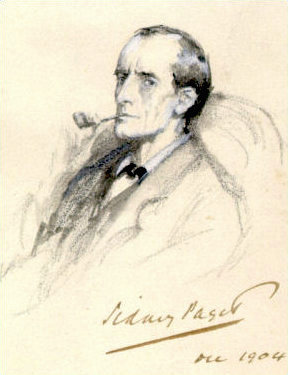
Sherlock Holmes is a fictional detective created by British author Arthur Conan Doyle. Referring to himself as a "consulting detective" in the stories, Holmes is known for his proficiency with observation, deduction, forensic science and logical reasoning that borders on the fantastic, which he employs when investigating cases for a wide variety of clients, including Scotland Yard.
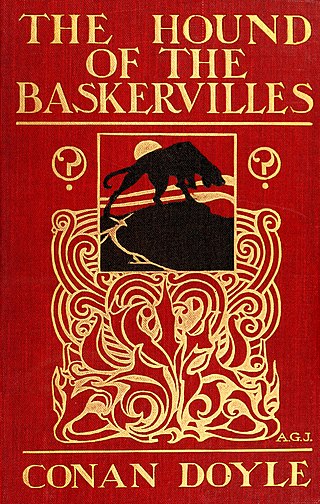
The Hound of the Baskervilles is the third of the four crime novels by British writer Arthur Conan Doyle featuring the detective Sherlock Holmes. Originally serialised in The Strand Magazine from August 1901 to April 1902, it is set in 1889 largely on Dartmoor in Devon in England's West Country and tells the story of an attempted murder inspired by the legend of a fearsome, diabolical hound of supernatural origin. Holmes and Watson investigate the case. This was the first appearance of Holmes since his apparent death in "The Final Problem", and the success of The Hound of the Baskervilles led to the character's eventual revival.

Professor James Moriarty is a fictional character and criminal mastermind created by Sir Arthur Conan Doyle to be a formidable enemy for the author's fictional detective Sherlock Holmes. He was created primarily as a device by which Doyle could kill Holmes and end the hero's stories. Professor Moriarty first appears in the short story "The Adventure of the Final Problem", first published in The Strand Magazine in December 1893. He also plays a role in the final Sherlock Holmes novel The Valley of Fear, but without a direct appearance. Holmes mentions Moriarty in five other stories: "The Adventure of the Empty House", "The Adventure of the Norwood Builder", "The Adventure of the Missing Three-Quarter", "The Adventure of the Illustrious Client", and "His Last Bow".

A Study in Scarlet is an 1887 detective novel by British writer Arthur Conan Doyle. The story marks the first appearance of Sherlock Holmes and Dr. Watson, who would become the most famous detective duo in literature. The book's title derives from a speech given by Holmes, a consulting detective, to his friend and chronicler Watson on the nature of his work, in which he describes the story's murder investigation as his "study in scarlet": "There's the scarlet thread of murder running through the colourless skein of life, and our duty is to unravel it, and isolate it, and expose every inch of it."

Mycroft Holmes is a fictional character appearing in stories written by Sir Arthur Conan Doyle from 1893 to 1908. The elder brother of detective Sherlock Holmes, he is a government official and a founding member of the Diogenes Club. Mycroft is described as having abilities of deduction and knowledge exceeding even those of his brother, though their practical use is limited by his dislike of fieldwork.
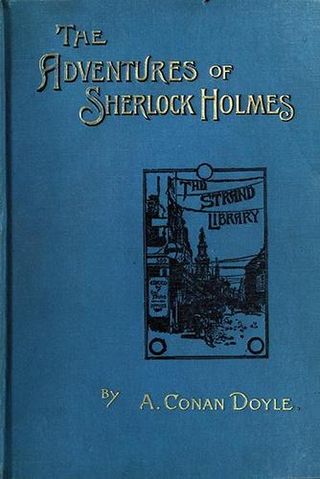
The Adventures of Sherlock Holmes is a collection of twelve short stories by British writer Arthur Conan Doyle, first published on 14 October 1892. It contains the earliest short stories featuring the consulting detective Sherlock Holmes, which had been published in twelve monthly issues of The Strand Magazine from July 1891 to June 1892. The stories are collected in the same sequence, which is not supported by any fictional chronology. The only characters common to all twelve are Holmes and Dr. Watson and all are related in first-person narrative from Watson's point of view.

The Case-Book of Sherlock Holmes is the final set of twelve Sherlock Holmes short stories by British writer Arthur Conan Doyle first published in the Strand Magazine between October 1921 and April 1927.

The Valley of Fear is the fourth and final Sherlock Holmes novel by British writer Arthur Conan Doyle. It is loosely based on the Molly Maguires and Pinkerton agent James McParland. The story was first published in the Strand Magazine between September 1914 and May 1915. The first book edition was copyrighted in 1914, and it was first published by George H. Doran Company in New York on 27 February 1915, and illustrated by Arthur I. Keller.

Nichols v. Universal Pictures Corporation, 45 F.2d 119, was a United States Court of Appeals for the Second Circuit case on copyright infringement by non-literal copying of a dramatic work. The Court held that copyright protection cannot be extended to the characteristics of stock characters in a story, whether it be a book, play, or film.
Sherlock Holmes has long been a popular character for pastiche, Holmes-related work by authors and creators other than Arthur Conan Doyle. Their works can be grouped into four broad categories:
Sheldon Reynolds was an American television producer best known for his involvement in the Sherlock Holmes franchise.

Traditionally, the canon of Sherlock Holmes consists of the 56 short stories and four novels written by Sir Arthur Conan Doyle. In this context, the term "canon" is an attempt to distinguish between Doyle's original works and subsequent works by other authors using the same characters.

The Enola Holmes Mysteries is a young adult fiction series of detective novels by American author Nancy Springer, starring Enola Holmes as the 14-year-old sister of an already famous Sherlock Holmes, twenty years her senior. There are seven books in the series, and one short story all written from 2006–2021.
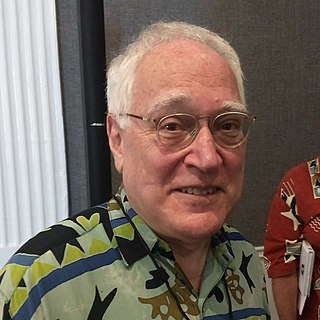
Leslie S. Klinger is an American attorney and writer. He is a noted literary editor and annotator of classic genre fiction, including the Sherlock Holmes stories and the novels Dracula, Frankenstein, and Strange Case of Dr. Jekyll and Mr. Hyde as well as Neil Gaiman's The Sandman comics, Alan Moore's and Dave Gibbons's graphic novel Watchmen, the stories of H.P. Lovecraft, and Neil Gaiman's American Gods.
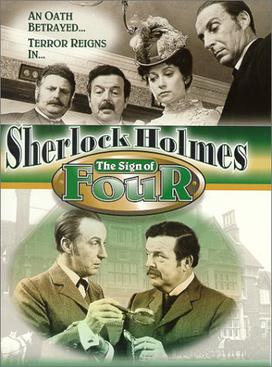
The Sign of Four is a 1983 British made-for-television mystery film directed by Desmond Davis and starring Ian Richardson and David Healy. The film is based on Sir Arthur Conan Doyle's 1890 novel of the same name, the second novel to feature Sherlock Holmes and Doctor Watson.

The New Annotated Sherlock Holmes is a series of three annotated books edited by Leslie S. Klinger, collecting all of Arthur Conan Doyle's short stories and novels about Sherlock Holmes. The books were originally published by W. W. Norton in oversized slipcased hardcover editions. The first two volumes containing the short stories were published on November 17, 2004, with the third volume containing the novels following a year later on November 17, 2005. Each volume was subsequently published separately on November 5, 2007 without a slipcase.
Copyright protection is available to the creators of a range of works including literary, musical, dramatic and artistic works. Recognition of fictional characters as works eligible for copyright protection has come about with the understanding that characters can be separated from the original works they were embodied in and acquire a new life by featuring in subsequent works.
"The Field Bazaar" is a short story by Arthur Conan Doyle, first published on November 20, 1896 in a special "Bazaar Number" of The Student, a publication of the students' representative council at Edinburgh University. It is a Sherlock Holmes story, published under Conan Doyle's byline and featuring both Holmes and his partner, Dr. John Watson. It is, however, treated by most experts as a parody or pastiche not suitable for inclusion in the traditional 60-story canon of Sherlock Holmes, though there are dissenters.
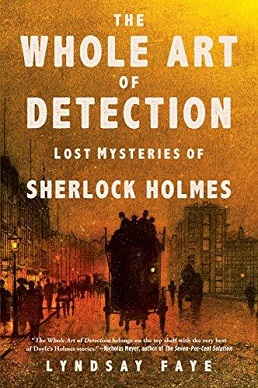
The Whole Art of Detection: Lost Mysteries of Sherlock Holmes is an anthology of Sherlock Holmes pastiche short stories by Lyndsay Faye. All but two of the stories have been previously published with 10 of the 15 stories were originally published in The Strand Magazine in slightly different form. The stories are divided chronologically into four sections: pre-Baker Street, the early adventures of Holmes and Watson, adventures during the "great hiatus", and the retirement years. Many of the stories are based on references in the Canon of Sherlock Holmes such as "Colonel Warburton’s Madness", a reference made in "The Adventure of the Engineer's Thumb".














